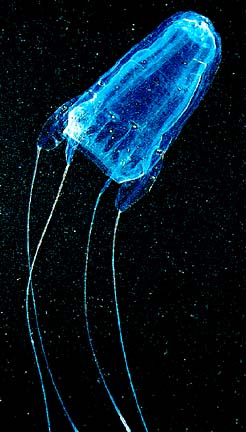Form and Function
The Hawaiian Box Jellyfish (Carybdea
alata) is a highly adapted species of jellyfish found in the
marine
habitat of the Pacific, Indian, and Atlantic Oceans
(Nagai et al. 2000). The adult Hawaiian Box Jellyfish has a
transparent bell which is about 50 mm wide, 50 mm in depth, and
has and average height of 80 mm (Yanagihara et al. 2001). In
order to capture their food Hawaiian Box Jellyfish have four
thin pinkish tentacles expanding from the corners of their
precisely square bells (Nomura et al. 2002) that contain
nematocysts found on the exumbrellar surface
(Yanagihara et al. 2001).
An individual Nematocyst contains a rigid venomous
capsule and an extremely coiled eversible tubule which is used
to capture its prey (Yanagihara et al. 2001). The discharge of
the venom from the Nematocyst occurs extremely fast at an
average rate of three micro seconds, piercing its preys, causing
paralysis. The
venom of Hawaiian Box Jellyfish
contains bioactive proteins that cause potent hemolytic
activity (the rupturing of red blood cells) in many of its prey
(Nagai et al. 2000), which along with the unique structural
properties of the nematocyst tubule contributes to this species
predatory success (Yanagihara, et al 2001).

The
Hawaiian Box Jellyfish belongs to the class Cubozoa which unlike other
jellyfish have image forming eyes that are advantageous in dark waters
(Coates 2002). This is because they are known to help capture and
focus light. These eyes are located on the rhopalia, which are small
sensory structures. Each rhopalium contains a large complex eye and a
small complex eye which make up its camera-type eyes. Each rhopalium
also has an identical set of pit eyes and an identical set of slit eyes
which are its ocelli. In order to see, each type of eyes contains
ciliated photoreceptors. A jellyfish medusa has a total of twenty-four
eyes because there are four rhopalia and six eyes per rhopalium (Coates
2002). Hawaiian Box Jellyfish, like most Cubozoans, prefer near shore
environments and near the bottom environments during the day. This is
due to the low frequency visual information, which is suitable for their
light mediated eyes.
As a Cubozoan, the Hawaiian Box Jellyfish have radial symmetry and a nervous system that is located around the margin of its bell. Both of these characteristics allow the Hawaiian Box Jellyfish to detect information from all around (Coates 2002). This information not only helps the Hawaiian Box Jellyfish detect prey and predators, but also helps execute their locomotion. The rhopalial ganglia contain the swim pace makers which use the nerve ring to communicate with each other. This stimulates the swim musculature producing locomotion. Since Hawaiian Box Jellyfish live in marine environments their locomotion is affected by the flow of the water so their sensory system is important (Coates 2002). Ultimately, without the rhopalia it would be sessile. The Hawaiian Box Jellyfish has a well-adapted form and function in order to sustain life in its tropical marine habitat.
<<<Habitat and Geography
